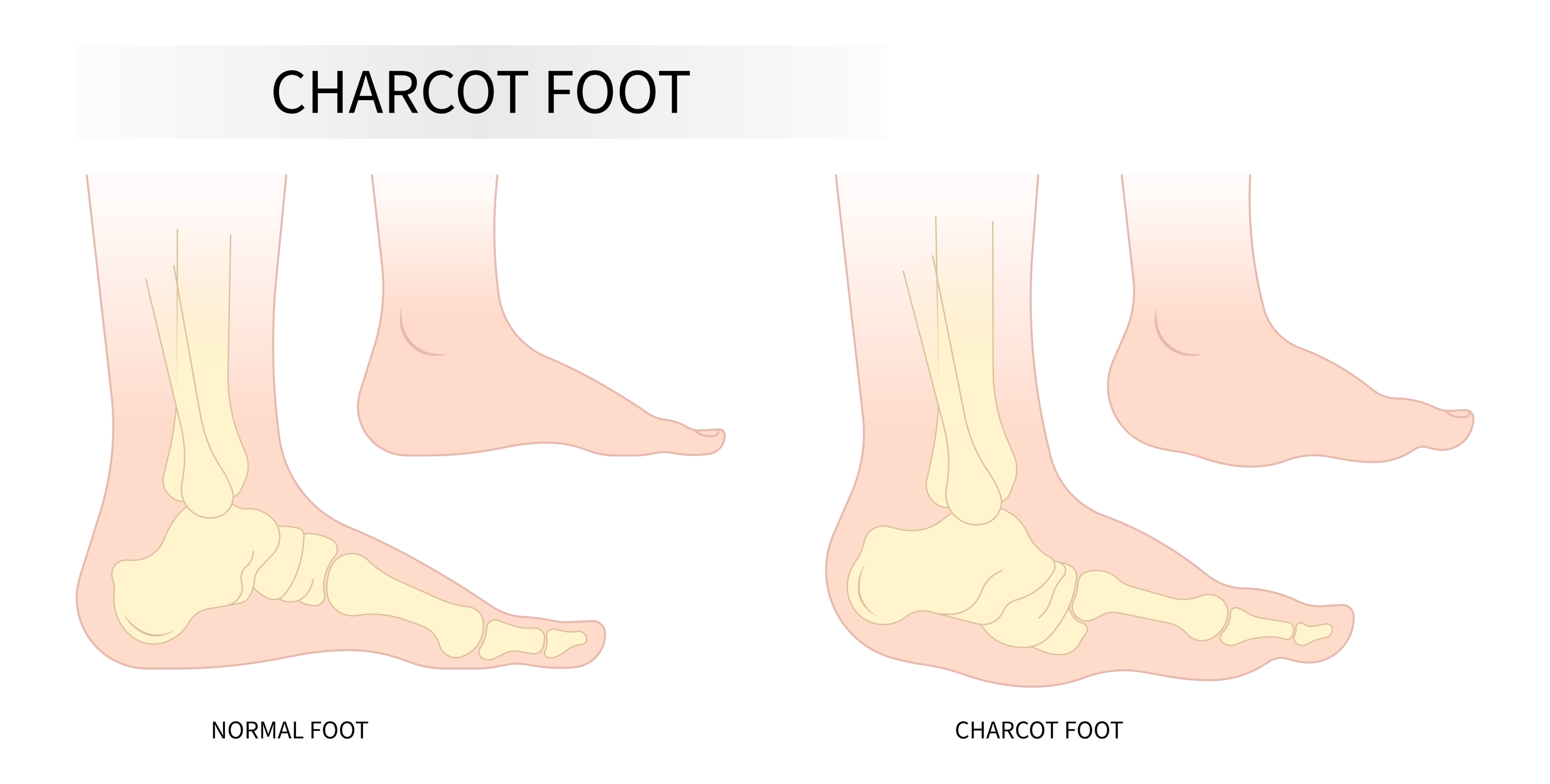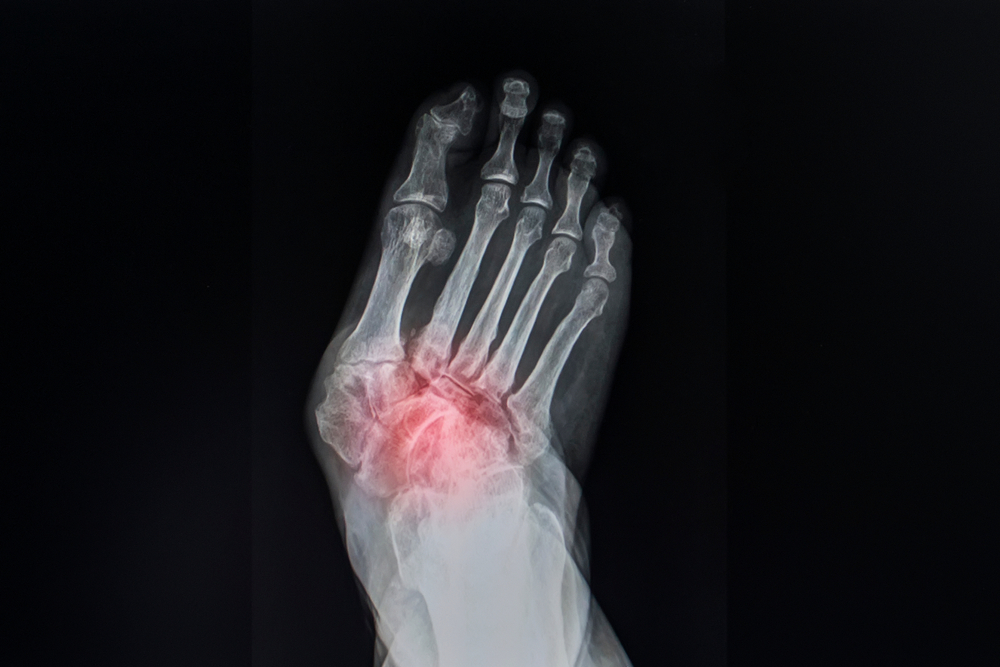Feet-Relief is supported by our audience. When you purchase through one of our links, we may earn a small affiliate commission. As an Amazon Associate I earn from qualifying purchases.Your cost is not affected.
When it comes to diabetes, complications can manifest in various ways, some more rare yet serious than others. One such complication is Charcot foot, a condition that can quietly wreak havoc on the bones, joints, and soft tissues of the foot and ankle. Often arising in individuals with long-standing diabetes and neuropathy, Charcot foot is a stealthy adversary that, if left untreated, can lead to significant deformities and even amputation. In this article, we’ll delve into the nuances of Charcot foot, exploring its causes, symptoms, treatment options, and the crucial role of healthcare providers in managing this challenging condition.
Charcot Foot: Understanding this Serious Diabetes Complication
Charcot foot is a rare but serious complication of diabetes that can lead to significant deformities and even amputation if left untreated. This condition affects the bones, joints, and soft tissues of the foot and ankle, causing them to become weak and eventually collapse. Charcot foot is more common in people who have had diabetes for a long time and have neuropathy, a condition that causes nerve damage and loss of sensation in the feet.
The following was written by a healthcare professional who works with foot and ankle surgeons treating this condistion. He hopes to help diabetics and others avoid charcot deformity problems and other diabetes complications through education.
Charcot Foot a Serious Diabetes Complication, Explained
Understanding Charcot’s Foot, also known as Charcot arthropathy, is a progressive condition that can develop over several months or years. It is caused by both neuropathy and trauma to the foot, which can result in fractures and dislocations that go unnoticed due to the lack of sensation. As a result, the foot becomes misshapen and unstable, making it difficult to walk and increasing the risk of falls and injuries.
The Connection Between Diabetes and Charcot Foot People with diabetes are at a higher risk of developing Charcot’s foot due to the nerve damage caused by high blood sugar levels. The loss of sensation in the feet can lead to unnoticed injuries and trauma, which can trigger the development of Charcot foot. It is important for people with diabetes to monitor their feet regularly and seek medical attention if they notice any signs of foot problems.
Key Takeaways
- Charcot foot is a serious complication of diabetes that can lead to significant deformities and even amputation if left untreated.
- Charcot’s foot is caused by both neuropathy and trauma to the foot, which can result in fractures and dislocations that go unnoticed due to the lack of sensation.
- People with diabetes are at a higher risk of developing Charcot foot due to the nerve damage caused by high blood sugar levels.

Understanding Charcot’s Foot
Charcot foot, also known as Charcot arthropathy or Charcot neuroarthropathy, is a rare but serious complication of diabetes-related neuropathy. It affects the bones, joints, and soft tissues of the foot and ankle, causing deformity and changing the shape of the foot.
The condition is named after Jean-Martin Charcot, a French neurologist who first described it in 1868. It is estimated that up to 2.5% of people with diabetes will develop Charcot foot at some point in their lives. While not the most common of diabetic foot problems, it presents some serious complications.
Peripheral Neuropathy
Charcot’s foot is caused by nerve damage, or neuropathy, which can lead to a loss of sensation in the foot and ankle. This means that people with Charcot foot may not feel pain or notice other signs of injury, such as swelling or redness, which can lead to further damage to the foot.
The most common cause of neuropathy is diabetes, but other conditions that affect the nerves, such as alcoholism, syphilis, and spinal cord injury, can also lead to Charcot foot.
Is It Charcot Deformity? Early Symptoms of Charcot’s Foot
The early signs of Charcot foot may be subtle and can easily be mistaken for other conditions. Symptoms may include swelling, redness, warmth, and pain in the foot or ankle. As the condition progresses, the foot may become deformed, with a “rocker-bottom” shape, and the skin may become thin and shiny.
It is important to seek medical attention if you experience any of these symptoms, especially if you have diabetes. Early diagnosis and treatment can help prevent further damage to the foot and reduce the risk of complications, such as ulcers, infections, and amputations.
In the next section, we will discuss the causes and risk factors of Charcot’s foot in more detail.
The Connection Between Diabetes and Charcot Foot
Charcot’s foot is a serious and potentially limb-threatening lower-extremity complication of diabetes. The condition is also known as Charcot arthropathy or neuropathic arthropathy. It is a rare condition that can cause significant deformities in the foot and ankle due to an inability to sense injuries. Neuropathy, or nerve damage, must be present for Charcot foot to develop, and the most common cause of that neuropathy is diabetes.
Poor Blood Flow
Diabetes can cause damage to small blood vessels, leading to poor circulation and nerve damage. High blood sugar levels can also damage nerves, which can lead to a loss of sensation in the feet and legs. This condition is known as diabetic neuropathy, and it can increase the risk of developing Charcot foot.
Poor Bone Quality Leading to Foot Problems
The development of Charcot foot is usually preceded by a minor injury, such as a sprain or fracture, that goes unnoticed due to the lack of sensation. The injury can cause inflammation and damage to the bones and joints in the foot, leading to deformities and instability.
People with diabetes who have high blood pressure or who have had the disease for a long time are at higher risk of developing Charcot foot. It is important for people with diabetes to monitor their blood sugar levels and to take steps to prevent complications such as Charcot foot.
In summary, Charcot foot is a rare but serious complication of diabetes that can lead to significant deformities and loss of function in the foot and ankle. Diabetes-related neuropathy is the most common cause of Charcot foot, and people with high blood pressure or long-standing diabetes are at higher risk. Monitoring blood sugar levels and taking steps to prevent complications are essential for people with diabetes.
Symptoms of Charcot Foot
Charcot foot is a rare complication of diabetes-related neuropathy that can cause significant damage to the bones and joints of your feet. The condition is caused by nerve damage that makes you lose feeling in your lower legs and feet, which can make injuries or infections more serious.
Some of the Common Symptoms of Charcot Foot:
- Swelling: Charcot foot can cause significant swelling in your feet and ankles, which can make it difficult to wear shoes or walk.
- Pain: While some people with Charcot foot may not experience any pain, others may experience significant pain in their feet or ankles.
- Warmth and redness: Because Charcot foot can cause inflammation in the bones and joints of your feet, you may notice that your feet feel warm or appear red.
- Loss of sensation: Because Charcot foot is caused by nerve damage, you may lose feeling in your feet and lower legs. This can make it difficult to detect injuries or infections.
- Changes in foot shape: Over time, Charcot foot can cause your foot to change shape, which can make it difficult to wear shoes or walk. You may notice that your arches collapse or that your toes curl under.
If you are experiencing any of these symptoms, it is important to see a healthcare professional as soon as possible. Early diagnosis and treatment can help prevent further damage to your feet and lower legs.
Diagnosis of Charcot Foot
As a healthcare professional, I know that diagnosing Charcot Foot can be challenging because its symptoms can mimic other foot conditions. However, early diagnosis is crucial in preventing permanent foot deformity that can lead to ulceration and amputation.
To diagnose Charcot Foot, I would start by taking a thorough medical history and performing a physical exam. During the physical exam, I would look for signs of inflammation, swelling, and redness. I would also check for loss of sensation and muscle weakness in the affected foot.
Imaging tests such as X-rays and magnetic resonance imaging (MRI) can help confirm the diagnosis of Charcot Foot. X-rays can show bone changes, while MRI can detect early inflammatory changes in the bones and soft tissues. A bone scan often shows the affected foot areas quite clearly.
Medical Treatment Begins With Diagnosis of Charcot Foot
It is important to note that Charcot Foot can be easily missed or misdiagnosed, especially in patients with diabetes-related neuropathy. Therefore, healthcare professionals should maintain a high index of suspicion and consider Charcot Foot in the differential diagnosis of any patient with diabetes who presents with foot pain, swelling, or redness.
In summary, the diagnosis of Charcot Foot requires a thorough medical history, physical exam, and imaging tests such as X-rays and MRI. Early diagnosis is crucial in preventing permanent foot deformity that can lead to ulceration and amputation.
Complications of Charcot Foot
Charcot Foot is a serious complication of diabetes that can lead to a range of complications. The condition can cause significant bone and joint disorganization, making it difficult to walk and move around. In severe cases, Charcot Foot can lead to amputation of the affected limb.
Acute Fractures
One of the most common complications of Charcot Foot is fractures. The weakened bones in the foot are more prone to fractures and can occur with minor trauma. These fractures can cause significant pain and swelling, making it difficult to walk or put weight on the affected foot.
Foot Ulceration
Another complication of Charcot Foot is foot ulcers. The disorganization of the bones and joints can create pressure points on the foot, which can lead to the development of foot ulcers. Foot ulcers are open wounds that can be difficult to heal and can increase the risk of infection.
Bone Infection and Soft Tissue Infections
Infections are another potential complication of Charcot Foot. The disorganization of the bones and joints can create areas where bacteria can thrive, increasing the risk of infection. In severe cases, infections can lead to the development of gangrene, which can be life-threatening.
Dislocations are also a potential complication of Charcot Foot. The disorganization of the bones and joints can cause the foot to become unstable, leading to dislocations. Dislocations can cause significant pain and swelling and can make it difficult to walk or put weight on the affected foot.
Overall, Charcot Foot can lead to a range of foot complications that can significantly impact a person’s quality of life. It is important to seek medical attention if you notice any changes in your foot, such as swelling, pain, or redness. Early diagnosis and treatment can help prevent complications and improve outcomes.
Treatment and Management of Charcot Foot
As a healthcare professional, I understand the importance of timely and appropriate treatment for Charcot foot. The goals of treatment are to relieve pain, prevent further deformity, and maintain mobility. The treatment plan may vary depending on the severity of the condition and the patient’s overall health.
Non-Surgical Treatment Options
Non-surgical treatment options may include:
- Immobilization: A cast or brace may be used to immobilize the foot and prevent further damage.
- Custom Shoes or Orthotics: Custom shoes or orthotics can help redistribute pressure on the entire foot and reduce the risk of injury.
- Medications: Pain relievers and anti-inflammatory medications may be prescribed to reduce pain and swelling.
Surgical Treatment Options
Surgery may be necessary in severe cases of Charcot foot. Surgery options include:
- Realignment Surgery: This surgery involves realigning the bones in the foot to improve stability and reduce the risk of further damage.
- Fusion Surgery: Fusion surgery involves fusing the bones in the foot together to create a stable and pain-free foot.
- Osteotomy: This procedure involves cutting and realigning the bone to reduce pressure on the foot.
Management of Charcot Foot
In addition to treatment options, proper management of Charcot foot is essential. The following management strategies can help prevent further damage and maintain mobility:
- Regular Foot Exams: Regular foot exams can help detect any changes in the foot and prevent further damage.
- Foot Care: Proper foot care, including daily washing, moisturizing, and inspection, can help prevent infections and other complications.
- Diabetes Management: Proper management of diabetes, including blood sugar control and regular check-ups, can help prevent complications such as Charcot foot.
I recognize the importance of a multidisciplinary approach to the treatment and management of Charcot foot. Collaboration between healthcare professionals, including podiatrists, endocrinologists, and orthopedic surgeons, can help ensure the best possible outcomes for patients with Charcot foot.
Prevention and Lifestyle Modifications
Preventing Charcot Foot is essential for people with diabetes. Here are some lifestyle modifications that can help prevent Charcot Foot:
Maintaining Healthy Blood Sugar Levels
Maintaining healthy blood sugar levels is crucial in preventing Charcot Foot. Consistently high blood sugar levels can cause nerve damage, leading to Charcot Foot. To maintain healthy blood sugar levels, follow a well-balanced diet and regularly monitoring blood sugar levels.
Proper Foot Care
Proper foot care is crucial in preventing Charcot Foot. Regularly inspecting the feet for cuts, blisters, and injuries help prevent Charcot Foot. Wash your feet daily and dry thoroughly, especially between your toes. Apply moisturizer to prevent dry skin.
Wearing Appropriate Footwear
Wearing appropriate footwear is essential in preventing Charcot Foot. Shoes that fit well and provide adequate support help prevent injuries and fractures. Choose shoes that are stable, have a wide toe box. Avoid any that put pressure on any particular point of the foot.
Regular Checkups
Regular checkups with a healthcare provider can help prevent Charcot Foot. During checkups, healthcare providers inspect the feet for any signs of Charcot Foot and provide appropriate treatment. Between checkups with your doctor, check your feet daily and contact your doctor if you notice changes.
Immobilization and Orthotics
In some cases, immobilization and orthotics helps prevent Charcot Foot. Immobilization helps prevent further damage to the foot, and orthotics provides support and stability to the foot. Ask your healthcare provider if immobilization or orthotics might prove helpful to you.
Exercise
Exercise often helps prevent Charcot Foot by improving circulation and reducing the risk of injuries. Set a schedule for exercise. Consider engaging in low-impact exercises like swimming, cycling, and walking at least 3 times a week.
Managing Risk Factors
Managing risk factors like obesity, smoking, and high blood pressure all help prevent Charcot Foot. Strive to maintain a healthy weight, quit smoking, and monitor your blood pressure levels on a regular basis.
Using a Cane
Using a cane can help reduce stress on the foot and prevent injuries. Ask your healthcare provider to determine if using a cane is necessary.
In conclusion, preventing Charcot Foot is crucial for people with diabetes. Maintaining healthy blood sugar levels, proper foot care, wearing appropriate footwear, regular checkups, immobilization and orthotics, exercise, managing risk factors, and using a cane are all effective ways to prevent Charcot Foot.
Role of Healthcare Providers in Managing Charcot Foot
As a healthcare provider, my role in managing Charcot Foot is crucial. Charcot Foot is a serious diabetes complication that can cause widespread destruction of bone and joint architecture, leading to loss of function. Early recognition of acute Charcot Foot is a diagnostic challenge, and it is important for healthcare providers to be aware of the condition’s pathophysiology, natural history, presentations, and treatment recommendations.
Diabetic Patients at Risk
The first step in managing Charcot Foot is to identify patients who are at risk. Patients with diabetes who have lost their protective sensation in their feet are at the highest risk of developing Charcot Foot. Therefore, healthcare providers should screen these patients regularly for the condition and educate them on the importance of foot care.
Once a patient is diagnosed with Charcot Foot, the healthcare provider’s role is to manage the condition appropriately. The primary goal of treatment is to prevent further damage to the foot and to promote healing. This may involve immobilization of the foot using a cast, brace, or splint, or the use of assistive devices such as crutches, a walker, or a wheelchair.
Treating Charcot Foot
In addition to immobilization, healthcare providers may also recommend weight-bearing restrictions, wound care, and the use of medications to manage pain and inflammation. Patients with Charcot Foot may also benefit from physical therapy to improve their mobility and reduce the risk of falls.
In severe cases of Charcot Foot, surgery may be necessary to correct bony prominences and restore the foot’s stability. In such cases, healthcare providers should refer patients to a foot specialist who has experience in managing Charcot Foot.
Prevent Charcot Deformity and Other Foot Problems
It is important to note that patients with Charcot Foot are at an increased risk of developing complications such as broken bones and sores. Therefore, healthcare providers should monitor these patients closely and provide appropriate care as needed.
In conclusion, as a healthcare provider, my role in managing Charcot Foot is critical. By identifying patients at risk, providing appropriate treatment, and monitoring for complications, I can help my patients manage this serious diabetes complication and improve their quality of life.
Safeguarding Your Feet from Charcot Foot Complexities
In our journey through the intricacies of Charcot foot, we’ve uncovered a condition that demands our attention and understanding, particularly among individuals with diabetes. This article has shed light on the causes, symptoms, diagnosis, and treatment options for Charcot foot, emphasizing the pivotal role of healthcare providers in managing this complex complication. By prioritizing early detection and a multidisciplinary approach to care, we can empower individuals with diabetes to protect their feet, preserve their mobility, and ultimately avoid the devastating consequences that Charcot Foot can bring.
Remember, knowledge is our most potent weapon against this silent adversary. With the correct information and vigilance, we can take proactive steps toward preventing Charcot deformity and its associated complications. cured, it can be managed with proper treatment. With early diagnosis and treatment, it is possible to prevent further damage and complications. Work closely with a healthcare professional to develop a treatment plan tailored to your needs.
Frequently Asked Questions
What is Charcot neuroarthropathy?
Charcot neuroarthropathy, also known as Charcot foot, is a rare complication of diabetes-related neuropathy. It can cause bones and joints in the foot to collapse or break, leading to a change in the foot’s shape. This condition is caused by an inability to sense injuries in the foot, which can result in significant deformities.
How is diabetic Charcot foot treated?
Treatment for diabetic Charcot foot typically involves immobilizing the foot to allow the bones and joints to heal. This can be accomplished with a cast or brace, or by using a Charcot Restraint Orthotic Walker (CROW). In some cases, surgery may be necessary to realign the bones and joints in the foot.
What is the acute stage of Charcot?
The acute stage of Charcot is characterized by inflammation and swelling in the affected foot. During this stage, it is important to immobilize the foot to prevent further damage and allow the bones and joints to heal.
What is the Charcot Restraint Orthotic Walker?
The Charcot Restraint Orthotic Walker (CROW) is a specialized brace that is used to immobilize the foot during the healing process. The CROW is custom-made for each patient and is designed to provide support and stability to the foot while allowing the patient to walk.
What is the mortality rate of Charcot foot?
The mortality rate of Charcot foot is difficult to determine, as it is a rare condition and there is limited data available. However, it is important to seek treatment as soon as possible to prevent further damage and complications.
Can Charcot neuroarthropathy be healed?
While Charcot neuroarthropathy cannot be cured, it can be managed with proper treatment. With early diagnosis and treatment, it is possible to prevent further damage and complications. Work closely with a healthcare professional to develop a treatment plan that is tailored to your individual needs.
Welcome to Feet-Relief.com – Your Foot Care Companion!
You’re in the right place if you’re looking for expert insights, comprehensive information, lifestyle tips, community support, and regular updates on managing diabetes-related foot issues.
Why Feet-Relief.com?
- Expert Insights: Our content is curated by experienced healthcare professionals, providing you with medically-backed guidance.
- Comprehensive Information: Find advice on managing toenail fungus, preventing foot ulcers, and understanding diabetic neuropathy.
- Lifestyle Tips: Learn practical tips on choosing the right footwear, maintaining hygiene, and controlling blood sugar levels.
- Community Support: Connect with others who share similar experiences and challenges in our online community.
- Regular Updates: Stay informed with the latest developments in diabetic foot care by subscribing to our newsletter.
At Feet-Relief.com, we believe that knowledge is the key to healthier feet. Explore our resources, join our community, and take steps towards better foot health. Your feet deserve the best care!
Visit Feet-Relief.com today!
Amazon and the Amazon logo are trademarks of Amazon.com, Inc, or its affiliates.





